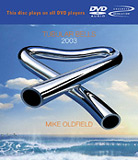June 2004
 There are, in the musical lives of all of us, certain special albums that we
remember and listen to again and again with true fondness. These landmark recordings
delineate with a startling clarity certain moments in our lives, bringing back full
memories of who we were, where we were, and what we were doing. There are, in the musical lives of all of us, certain special albums that we
remember and listen to again and again with true fondness. These landmark recordings
delineate with a startling clarity certain moments in our lives, bringing back full
memories of who we were, where we were, and what we were doing.
For me, Mike Oldfield’s Tubular Bells, as originally released in 1973, was one such album. I can easily remember when it hit the charts, and I listened, utterly amazed, as it stayed there far longer than any instrumental album had any right doing. My favorite radio station at the time, CHOM out of Montreal, Canada, used to play one cut from each of its top-ten records each weekend. And Tubular Bells -- the single -- was a mainstay on the upper end of that program for well over a year. My friends and I wore out multiple copies of that record (they were vinyl then) due to repeated playings, constantly amazed at the accomplishments of one person, Oldfield, who played all the instruments and co-engineered the recording. Its almost magical swirl of musical sounds was astounding in those stereo-only days, as was its early release as a 4-channel recording on SACD (and yes, I bought that one too). But Tubular Bells has never been a completely satisfying recording, either as a stereo or quad, for Mike Oldfield. As he told Hi-Fi News in November 2003, "I wasn’t happy with the original. Most of it was recorded in one week and I wanted there to be, for my own satisfaction, a really well-produced and well-performed, good-sounding version of it." So, armed with that determination, Oldfield decided to re-do Tubular Bells using all the advantages of modern sound-recording technology. The result, Tubular Bells 2003, is as close to a note-for-note replay (re-recording, remake, redo, copy, whatever you want to call it) as he could do. In order to get as close to the original as is humanly (and technologically) possible, Oldfield transferred all the original 16 tracks to his favored Logic Audio Platinum computer program. He then went as close to a note-for-note re-recording as he could. But, due to the changes in technology now available and his desire to update certain parts he was never happy with, Oldfield re-did certain aspects, so a comparison between this new DVD-A and the SACD -- which is a straight analog-to-four-channel-DSD transfer of the original -- are, while possible, not really valid. Still, listening to both back to back makes for an enlightening experience -- provided, of course, that you have both recordings and the means to play each back in high-resolution audio. I do (as well as having an original vinyl copy), and the SACD really opens up the soundstage in a much fuller manner than the stereo original could ever hope to accomplish. If you haven’t heard it, and have always been a fan, the SACD will be something of a revelation. But the new Tubular Bells 2003, in its DVD-A format is far and away a different beast from the SACD. Oldfield, as both recording artist and producer, took the original’s magnificent swirling patterns and gave then all a swift kick in the kiester. Now, many of the instruments simply fly around the soundstage, immersing the listener in totally new sonic wonders. And it seems just as you get a fix on something, boom, it’s gone, replaced by another sound while the initial one is now moved to completely different point of origin. And while this type of engineering wouldn’t work with all musical forms (classical leaps initially to mind), on Tubular Bells 2003 it not only works well, but it made me wonder how I could have ever been satisfied with the sonics of any previous issue. And check out the new voice of the announcer -- it’s John Cleese! Cool. Tubular Bells 2003 is not about sound with no real musical content. Oldfield’s canon of works has always been praised for its high level of production values. The clarity and proper tonal balances given each instrument, together with careful placement and layering, results in a level of musical appreciation that will please even the most demanding of audiophile criteria. Just how much of an improvement is the 24/48 high-resolution layer is over Dolby Digital? And yes, you heard me right; the high-resolution layer is done at 24/48. Oldfield, it seems, feels that there is nothing to be gained by going to any higher sampling rates. I guess everyone’s entitled to his or her own opinion, especially the artist/producer. As to the answer: The high-resolution layer is worlds better, as even Oldfield will attest. Tubular Bells 2003 comes in advanced-resolution stereo and multichannel, Dolby Digital 5.1, DTS 5.1, and Dolby stereo sound, all on one disc. There are also significant bonus features as well, such as excerpts from the videos of Tubular Bells II – Live At Edinburgh Castle and Tubular Bells 3 – Live At Horseguards Parade, London, as well as the original audio demo tapes. All in all, a well-rounded, well-thought-out, value-laden package. If you’re a Tubular Bells lover like me, you’ll want copies of all three releases: vinyl, SACD and this new DVD-A. But if you’re new to this music (and I envy you your initial listen), then this DVD-A of Tubular Bells 2003 is the only copy you’ll need. It’s all here, exactly as Mike Oldfield -- happy now -- wants you to hear it. GO BACK TO: |
 Mike Oldfield - Tubular
Bells 2003
Mike Oldfield - Tubular
Bells 2003